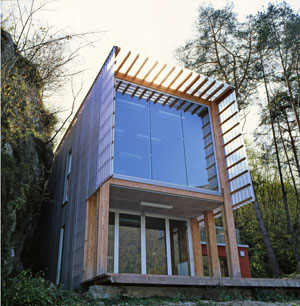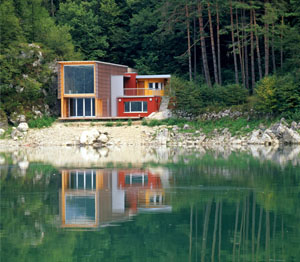| Card n. | Description | Locality | Linked sites |
| 51 | Experimental Fish Genetics Centre | Farra d’Alpago | 130 |
| file .pdf | Contemporary Architecture (AC) | Google maps |
 |
 |
 |
- Description
- How to get there
- Interesting facts
- Bibliography
On the southern shore of Santa Croce Llake, what was once a small masonry construction used as a shelter for boats has today been turned into a modern two-storey building, designed to be used as an experimental centre to restore the fish population to its former levels and to provide information on the environmental activities of the lake. On the ground floor are the systems of the centre and the study of the biologist in charge, while on the first floor there is a teaching room, the tanks for the fish and the security office. The relationship between the centre and the lake is a significant one, not only for the work carried out there, but also for the particular atmosphere created by the terraces, the materials and the large windows, and how they engage with the surrounding environment.
From the centre of the village of Farra d’Alpago, or from the Fadalto exit of the A27, go through the neighbourhood of Santa Croce del Lago. Near the bend with the Hotel Miralago, there is a little road that goes down towards the lake (1 km), to the so-called Baia delle Sirene, or Mermaids’ Bay, where you can park. From here, a footpath along the lakeshore will take you to the Fish Genetics Centre.
Along the western shore of the lake - SS51 – are the other constructions described; specifically, at the railway underpass, where you will find signs for Cornolade and the agritourist farm.
ACCESSIBLE: yes, the outside of the centre
MUNICIPALITY: Farra d’Alpago
PLACE: Santa Croce lake, Baia delle Sirene
GEOGRAPHICAL COORDINATES: X 1758066 - Y 5109450
PROVINCE: Belluno
FILE COMPILED BY: Guadagnin
As regards interesting architectures that look onto the water, it is worth mentioning the very first Church of Santa Croce, in the municipality of Farra d'Alpago, mentioned in a papal bull as early as 1185. On the outside of the church, destroyed and rebuilt between 1876 and 1879, are a number of interesting sculptural fragments dating back to the 10th century, as well as the funeral monument to Paul Imhof, from the last quarter of the 15th century.
Also along the road that runs from the Fadalto Saddle to La Secca are numerous examples of minor religious architecture, such as capitals and aedicules erected by tradesmen who had survived accidents or nights out in the worst of weather, or in memory of others who had perished during their travels. There are also two memorial stones carved directly into the rock, approximately at km 29.7 of the road, above the railway. The two stones are in memory of two articular events:
The first is dedicated to the Podestà and Captain Agostino Da Mula - AVG. AMVLIO / P.P.Q. BENEFICENTISS. / HAC VIA / CONSTRVCTA . PURGATA . REFECTA / BELLUNEN. P. / M.D.VC. -, who probably had the road repaired at the end of the 16th century, in 1595; the secondi s more difficult to make out because it is positioned higher up, and is dedicated to the Podestà and Captain of Belluno Luigi Barbarico (1644). It reads:
LAPIDOSAS ET PRAERVPTAS MONTIUM RADICES / QUAE AD BELLVNENSES et ulTERIORES NORICOS / INTERCLVDEBANT acCEssum AlOYSII BARBADICI / BELLVNI P.P.Q. PRAESTanTISSimi soLERTIA SECUIT / PERVIAS ET AD COMmodIOREM currICVLORVM / REDDIDIT USVM M. D. C. xl. IV.
Near this area downstream from the railway is a large calchera, or lime kiln, with a limestone quarry, both operated by a family from the village of Cornolade until the 1950s.
F. Pilgrims, Notizie storiche su Ponte nelle Alpi, Bologna, 1985
A. Boito, Studio d’ambiente – il comune di Ponte nelle Alpi, Ponte nelle Alpi, 1963
Documentation supplied by Studio Parcianello & Partners engineering s.r.l.

